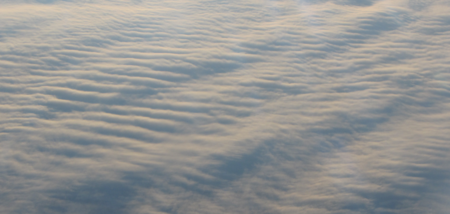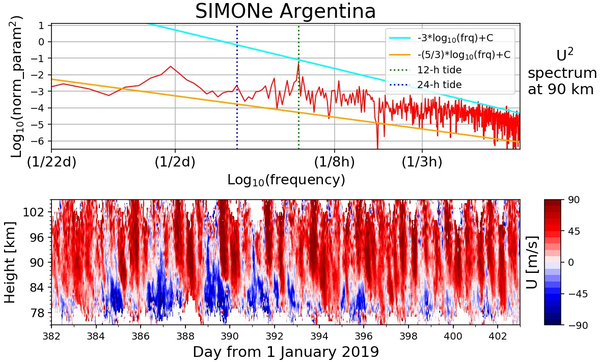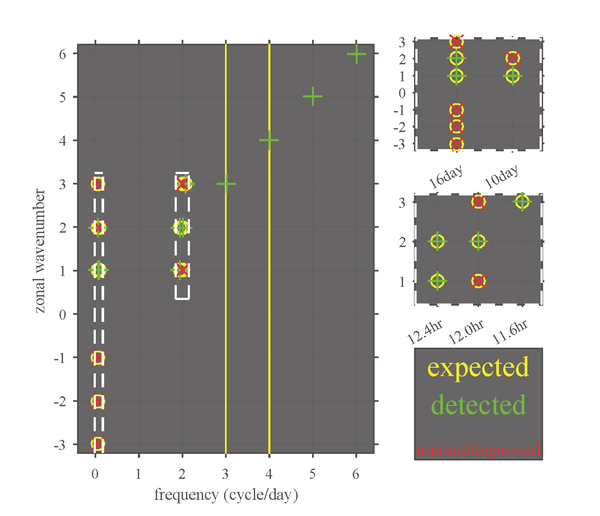- Research Topics
- Department Optical and Rocket Soundings
- Department Radar Remote Sensing
- Department Modelling of Atmospheric Processes
- Working Group Satellite Data Analysis
- Cross-departmental Collaborations
- Projects
- Publications
Atmospheric waves and their role in coupling processes

The terrestrial atmosphere can be described as a stratified and vertically structured mix of gases. Based on its vertical temperature profile, the atmosphere can be divided into different regions, i.e., the troposphere, stratosphere, mesosphere, and thermosphere. These regions are coupled by various mechanisms, which can be categorized into two main groups: forcing from below (e.g., atmospheric circulation, disturbances, and waves) and forcing from above (e.g., solar irradiance, magnetospheric activity, and heliospheric structures).
Atmospheric waves are fluctuating motions of the neutral air in the terrestrial atmosphere. These waves have different temporal (some minutes to a few weeks) and spatial (meters to thousands of kilometers) scales. They have a significant impact on the wind, air density, pressure and temperature fields and are usually identified as fluctuations of these parameters. Waves are mainly excited in the troposphere and stratosphere, and propagate vertically and also horizontally. While propagating, waves will transport energy and momentum from their source regions across the atmosphere and will be able to dissipate under special circumstances. The wave breaking is associated with the transmission of energy and momentum. By means of this energy and momentum transfer, atmospheric waves contribute considerably to the coupling of different layers in the atmosphere.
Atmospheric waves can be categorized into three main groups: planetary waves (PWs), tides and gravity waves (GWs); all of them subject of research at IAP. PWs are global scale waves that try to bring the atmosphere to balance by transferring heat from the equator towards the poles and cold air in the opposite direction. The meridional gradient of the Coriolis force acts as their restoring force. Tides exhibit periods that are sub-harmonics of the solar or lunar day, and can be excited either thermally or gravitationally. GWs are local (and regional) waves that result from buoyancy acting on parcels of air displaced from hydrostatic equilibrium. GWs can only exist in a stable stratified atmosphere. Besides, nonlinear interactions of waves from the above groups may give rise to diverse secondary waves. The properties, propagation, and impact of all these waves on the background atmosphere are investigated in our Department by using a combination of partial reflection, mesosphere-stratosphere-troposphere (MST) and specular meteor radars, supported by local and regional optical observations and global satellite observations (e.g., TIMED-SABER), reanalysis data (ECMWF, MERRA2) and global circulation model simulations (e.g., KMCM, WACCM-X, HAMMONIA).

Of particular interest for our Department is the study of coupling processes associated with sudden stratospheric warmings (SSW) events. In the winter polar region, upward propagating PWs triggered by the horizontal thermal gradient of the land-sea distribution, may interact with the polar vortex and heat the stratosphere rapidly, in a phenomenon commonly known as SSW. SSWs impact the upper atmosphere influencing both neutral and plasma properties, such as the neutral density and composition, temperature, wind, plasma density, and electric current density.
Conventionally, single-station approaches allow investigating waves only according to their periods but are not capable of resolving their spatial scales. In a series of works, we have developed multi-station approaches to combine observations from different longitudinal sectors to diagnose the spatial scale of waves during SSWs. As summarized in Figure 3, by measuring the zonal wavenumbers of waves seen in the previous single-station analyses, we were able to resolve waves with the same period but different zonal scales (e.g., the lunar tide and a secondary wave due to PW-tide interactions, He et al., 2018a, 2018b), to disprove some waves that had been previously reported (e.g., two semidiurnal solar non-migrating tides, He & Chau 2019), and to discover new wave activities (e.g., 4-h migrating tide, He et al., 2020a).
Besides, among other efforts, coupling during SSWs has also been studied in terms of the tide-PW nonlinear interaction energy budget (He et al., 2017), and in connection with the polar vortex at mesospheric heights (Conte et al., 2019), and the interhemispheric meridional circulation (Laskar et al., 2019).

Publications
- He, M., Yamazaki, Y., Hoffmann, P., Hall, C. M., Tsutsumi, M., Li, G., & Chau, J. L. (). Zonal wavenumber diagnosis of Rossby‐wave‐like oscillations using paired ground‐based radars. , J. Geophys. Res., 125, doi:e2019JD031599, 2020b.
- He, M., Forbes, J. M., Chau, J. L., Li, G., Wan, W., & Korotyshkin, D. V. ( 2020). High‐order solar migrating tides quench at SSW onsets. Geophys. Res. Lett, 47, e2019GL086778, doi:10.1029/2019GL086778, 2020a
- J. F. Conte, J. L. Chau and D. H. W. Peters, Middle and high latitude mesosphere and lower thermosphere mean winds and tides in response to strong Polar-night jet oscillations, J. Geophys. Res., 124, 9262-9276, doi:10.1029/2019JD030828, 2019.
- M. He and J. L. Chau, Mesospheric semidiurnal tides and near-12 h waves through jointly analyzing observations of five specular meteor radars from three longitudinal sectors at boreal midlatitudes, Atmos. Chem. Phys., 19, 5993-6006, doi:10.5194/acp-19-5993-2019, 2019.
- F. I. Laskar, J. P. McCormack, J. L. Chau, D. Pallamraju, P. Hoffmann and R. P. Singh, Interhemispheric meridional circulation during sudden stratospheric warming, J. Geophys. Res., 124, 7112-7122, doi:10.1029/2018JA026424, 2019.
- S. Wilhelm, G. Stober and P. Brown, Climatologies and long-term changes of mesospheric wind and wave measurements based on radar observations at high and mid latitudes, Ann. Geophys., 37, 851-875, doi:10.5194/angeo-37-851-2019, 2019.
- J. F. Conte, J. L. Chau, F. I. Laskar, G. Stober, H. Schmidt and P. Brown, Semidiurnal solar tide differences between fall and spring transition times in the northern hemisphere, Ann. Geophys., 36, 999-1008, doi:10.5194/angeo-36-999-2018, 2018.
- M. He, J. L. Chau, G. Stober, G. Li, B. Ning and P. Hoffmann, Relations between semidiurnal tidal variants through diagnosing the zonal wavenumber using a phase differencing technique based on two ground-based detectors, J. Geophys. Res., 123, 4015-4026, doi:10.1002/2018JD028400, 2018.
- M. He, J. L. Chau, C. M. Hall, M. Tsutsumi, C. Meek und P. Hoffmann, The 16-day planetary wave triggers the SW1-tidal-like signatures during 2009 sudden stratospheric warming, Geophys. Res. Lett., 45, 12631-12638, doi:10.1029/2018GL079798, 2018.












